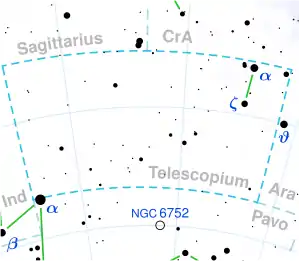HD 171819
HD 171819, also known as HR 6986 or rarely 22 G. Telescopii, is a solitary star[14] located in the southern constellation Telescopium. It is faintly visible to the naked eye as a white-hued object with an apparent magnitude of 5.84.[2] The object is located relatively close at a distance of 313 light years based on Gaia DR3 parallax measurements, but it is approaching the Solar System with a heliocentric radial velocity of −9 km/s.[6] At its current distance, HD 171819's brightness is diminished by one-quarter of a magnitude due to interstellar dust[15] and it has an absolute magnitude of +0.65.[7]
 | |
| Observation data Epoch J2000.0 Equinox J2000.0 (ICRS) | |
|---|---|
| Constellation | Telescopium |
| Right ascension | 18h 39m 14.29289s[1] |
| Declination | −47° 54′ 35.1520″[1] |
| Apparent magnitude (V) | 5.84±0.01[2] |
| Characteristics | |
| Spectral type | A7 IV/V[3] or A3 V[4] |
| B−V color index | +0.23[5] |
| Astrometry | |
| Radial velocity (Rv) | −9±4.3[6] km/s |
| Proper motion (μ) | RA: +25.426 mas/yr[1] Dec.: +13.951 mas/yr[1] |
| Parallax (π) | 10.4348 ± 0.1045 mas[1] |
| Distance | 313 ± 3 ly (95.8 ± 1.0 pc) |
| Absolute magnitude (MV) | +0.65[7] |
| Details | |
| Mass | 1.73+0.37 −0.19[8] M☉ |
| Radius | 3.37±0.17[9] R☉ |
| Luminosity | 33.3±0.1[1] L☉ |
| Surface gravity (log g) | 3.60±0.08[8] cgs |
| Temperature | 7,512[10] K |
| Metallicity [Fe/H] | −0.02[11] dex |
| Age | 855[1] Myr |
| Other designations | |
| Database references | |
| SIMBAD | data |
HD 171819 has a stellar classification of A7 IV/V, indicating that the object is a late A-type star with the blended luminosity class of a main sequence star and subgiant.[3] However, astronomer William Buscombe gave it a class of A3 V,[4] instead making it an ordinary A-type main-sequence star. Evolutionary models give it an age of 855 million years and place it towards the end of its main-sequence life.[1] At present it has 1.73 times the mass of the Sun[8] and a slightly enlarged radius 3.37 times that of the Sun.[9] It radiates 33.3 times the luminosity of the Sun[1] from its photosphere at an effective temperature of 7,512 K.[10] HD 171819 has a near solar metallicity at [Fe/H] = −0.02.[11]
References
- Vallenari, A.; et al. (Gaia collaboration) (2023). "Gaia Data Release 3. Summary of the content and survey properties". Astronomy and Astrophysics. 674: A1. arXiv:2208.00211. Bibcode:2023A&A...674A...1G. doi:10.1051/0004-6361/202243940. S2CID 244398875. Gaia DR3 record for this source at VizieR.
- Høg, E.; Fabricius, C.; Makarov, V. V.; Urban, S.; Corbin, T.; Wycoff, G.; Bastian, U.; Schwekendiek, P.; Wicenec, A. (March 2000). "The Tycho-2 catalogue of the 2.5 million brightest stars". Astronomy and Astrophysics. 355: L27–L30. Bibcode:2000A&A...355L..27H. ISSN 0004-6361. S2CID 17128864.
- Houk, Nancy (1978). Michigan catalogue of two-dimensional spectral types for the HD stars: Declinations −53° to −40°. Vol. 2. Bibcode:1978mcts.book.....H.
- Buscombe, W. (1 May 1969). "Line Strengths for Southern OB stars--II: Observations with Moderate Dispersion". Monthly Notices of the Royal Astronomical Society. 144 (1): 31–39. Bibcode:1969MNRAS.144...31B. doi:10.1093/mnras/144.1.31. ISSN 0035-8711.
- Stoy, R. H. (1968). "Photoelectric Magnitudes and Colours for Bright Southern Stars". Monthly Notes of the Astronomical Society of South Africa. 27: 119. Bibcode:1968MNSSA..27..119S. ISSN 0024-8266.
- Gontcharov, G. A. (November 2006). "Pulkovo Compilation of Radial Velocities for 35,495 Hipparcos stars in a common system". Astronomy Letters. 32 (11): 759–771. arXiv:1606.08053. Bibcode:2006AstL...32..759G. doi:10.1134/S1063773706110065. eISSN 1562-6873. ISSN 1063-7737. S2CID 119231169.
- Anderson, E.; Francis, Ch. (May 2012). "XHIP: An extended hipparcos compilation". Astronomy Letters. 38 (5): 331–346. arXiv:1108.4971. Bibcode:2012AstL...38..331A. doi:10.1134/S1063773712050015. eISSN 1562-6873. ISSN 1063-7737. S2CID 119257644.
- Stassun, Keivan G.; et al. (9 September 2019). "The Revised TESS Input Catalog and Candidate Target List". The Astronomical Journal. 158 (4): 138. arXiv:1905.10694. Bibcode:2019AJ....158..138S. doi:10.3847/1538-3881/ab3467. eISSN 1538-3881. hdl:1721.1/124721. S2CID 166227927.
- Kervella, P.; Thévenin, F.; Di Folco, E.; Ségransan, D. (October 2004). "The angular sizes of dwarf stars and subgiants. Surface brightness relations calibrated by interferometry". Astronomy & Astrophysics. 426 (1): 297–307. arXiv:astro-ph/0404180. Bibcode:2004A&A...426..297K. doi:10.1051/0004-6361:20035930. eISSN 1432-0746. ISSN 0004-6361. S2CID 6077801.
- Stassun, Keivan G.; Oelkers, Ryan J.; Pepper, Joshua; et al. (20 August 2018). "The TESS Input Catalog and Candidate Target List". The Astronomical Journal. 156 (3): 102. arXiv:1706.00495. Bibcode:2018AJ....156..102S. doi:10.3847/1538-3881/aad050. eISSN 1538-3881. S2CID 73582386.
- Gontcharov, G. A. (December 2012). "Dependence of kinematics on the age of stars in the solar neighborhood". Astronomy Letters. 38 (12): 771–782. arXiv:1606.08814. Bibcode:2012AstL...38..771G. doi:10.1134/S1063773712120031. eISSN 1562-6873. ISSN 1063-7737. S2CID 118345778.
- Gould, Benjamin Apthorp (1878). "Uranometria Argentina : brillantez y posicion de las estrellas fijas, hasta la septima magnitud, comprendidas dentro de cien grados del polo austral : con atlas". Resultados del Observatorio Nacional Argentino. 1. Bibcode:1879RNAO....1.....G.
- "HD 171819". SIMBAD. Centre de données astronomiques de Strasbourg. Retrieved March 26, 2022.
- Eggleton, P. P.; Tokovinin, A. A. (11 September 2008). "A catalogue of multiplicity among bright stellar systems". Monthly Notices of the Royal Astronomical Society. 389 (2): 869–879. arXiv:0806.2878. Bibcode:2008MNRAS.389..869E. doi:10.1111/j.1365-2966.2008.13596.x. eISSN 1365-2966. ISSN 0035-8711. S2CID 14878976.
- Gontcharov, George A.; Mosenkov, Aleksandr V. (28 September 2017). "Verifying reddening and extinction for Gaia DR1 TGAS main sequence stars". Monthly Notices of the Royal Astronomical Society. 472 (4): 3805–3820. arXiv:1709.01160. Bibcode:2017MNRAS.472.3805G. doi:10.1093/mnras/stx2219. eISSN 1365-2966. ISSN 0035-8711. S2CID 118879856.